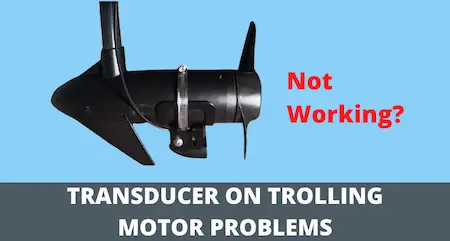The Most Common Transducer On Trolling Motor Problems (And How To Fix Them)
UPDATED 17 MAY 2023
If your transducer is mounted on the trolling motor, a number of problems can arise from this setup.
It’s important to be aware of these issues, as well as the best practices for avoiding them and fixing them if necessary.
In this article we’ll walk you through the most common problems that can occur with transducers on trolling motors, and how to deal with them.

What are the most common problems with transducers on trolling motors?
The most common issues that occur with transducers mounted on trolling motors are as follows:
- Trolling motor interference
- Damage to transducer cable
- Damage to transducer itself from rocks
An easy way to avoid the latter two issues is to get a trolling motor with built-in transducer, which takes care of protecting the transducer and its cable.
However, on the down side, this often restricts you to using only one kind of transducer, which may not be ideal for your purposes.
Now let’s take a closer look at each of these problems, and discuss how you can prevent them from happening, or fix them if they do occur.
What causes trolling motor interference?
Trolling motor interference is most often caused by electromagnetic interference, and in some cases by mechanical interference.
Mechanical interference is usually due to the rotation of the propeller, which creates vibrations in the water that can affect the transducer.
Also, the vibration of the motor itself inside the motor compartment (which is precisely where the transducer is mounted) can sometimes cause interference.
If this is the case, it usually helps to place a piece of rubber between the motor compartment and the transducer mount during installation.
Electromagnetic trolling motor interference is caused by the powerful electromagnetic field that is created by an actively deployed trolling motor, which explains why it tends to be stronger when using more powerful trolling motors.
Also, if the trolling motor isn’t properly grounded, this usually makes the interference effect worse, since there are current “leaks” that can affect both the transducer and its cable.
How do you stop trolling motor interference?
In order to avoid electromagnetic interference, the first thing to do is reduce the sensitivity setting of your fish finder. If you find that reducing it down to 70 or 80% gets rid of most of the interference, while still enabling you to get a good image on the display, this is the easiest way to solve the problem.
Secondly, make sure that you run the transducer cable as far away as possible from the power cable of the trolling motor (ideally on opposite sides of the boat), to avoid electromagnetic interference. Also, make sure to run the transducer cable as far away as possible from the cable of your foot pedal, for the same reason.
Finally, it’s also important to ground the trolling motor properly, as that can help a lot to reduce interference. You may have to ground specific parts of the motor, depending on where the most interference originates.
Using a trolling motor interference choke
A great tool to help reduce electromagnetic interference is a ferrite choke or ferrite bead. Motorguide has one of these, called an RF choke, that you can use to reduce the effect of interference on the transducer cable. Humminbird also provides cables that come with a built-in ferrite choke.
Essentially, the RF choke is a small ring, through which you thread your cable 5 to 6 times. The ferrite inside the choke then acts as a filter that eliminates a large part of the electromagnetic noise.
How do you protect the transducer cable on a trolling motor?
Since the transducer cable needs to run along the whole length of the trolling motor shaft, it easily gets pinched, pulled, or even crushed when the motor is stowed. In order to avoid this, it’s important to route and attach the cable very carefully along the shaft and the mount of the motor.
It’s best to run the cable tightly upwards from the motor compartment, so it never gets close to the rotating prop. Also, you’ll want to run it up the side of the shaft that faces upwards when the trolling motor is stowed on its cradle, so it doesn’t get caught underneath the motor when it is stowed.
Finally, it’s also a good idea to use one or more cable hoops on the trolling motor mount, to ensure the transducer cable is kept away from the areas where it can get pinched when you retract and stow the motor.
How do you protect the transducer on a trolling motor?
The best way to protect the transducer on a trolling motor is to stow the motor whenever you move into shallow water, or notice that you’re getting too close to rocks or mussel beds.
However, this isn’t always feasible, since you usually need to use the trolling motor precisely in these circumstances. So here are a couple of additional things you can do to protect the transducer.
First of all, make sure that the transducer doesn’t protrude farther down into the water than the skeg. That way, when the skeg hits an object in the water, it will tend to protect the transducer from the impact.
Secondly, use a flexible cable tie instead of a rigid metal hose clamp to attach the transducer mounting bracket to the motor. That way, if the transducer hits an object, it will tend to be pushed off to one side, instead of breaking. But if this does happen, you’ll need to recenter the transducer, to make sure it points straight down.
